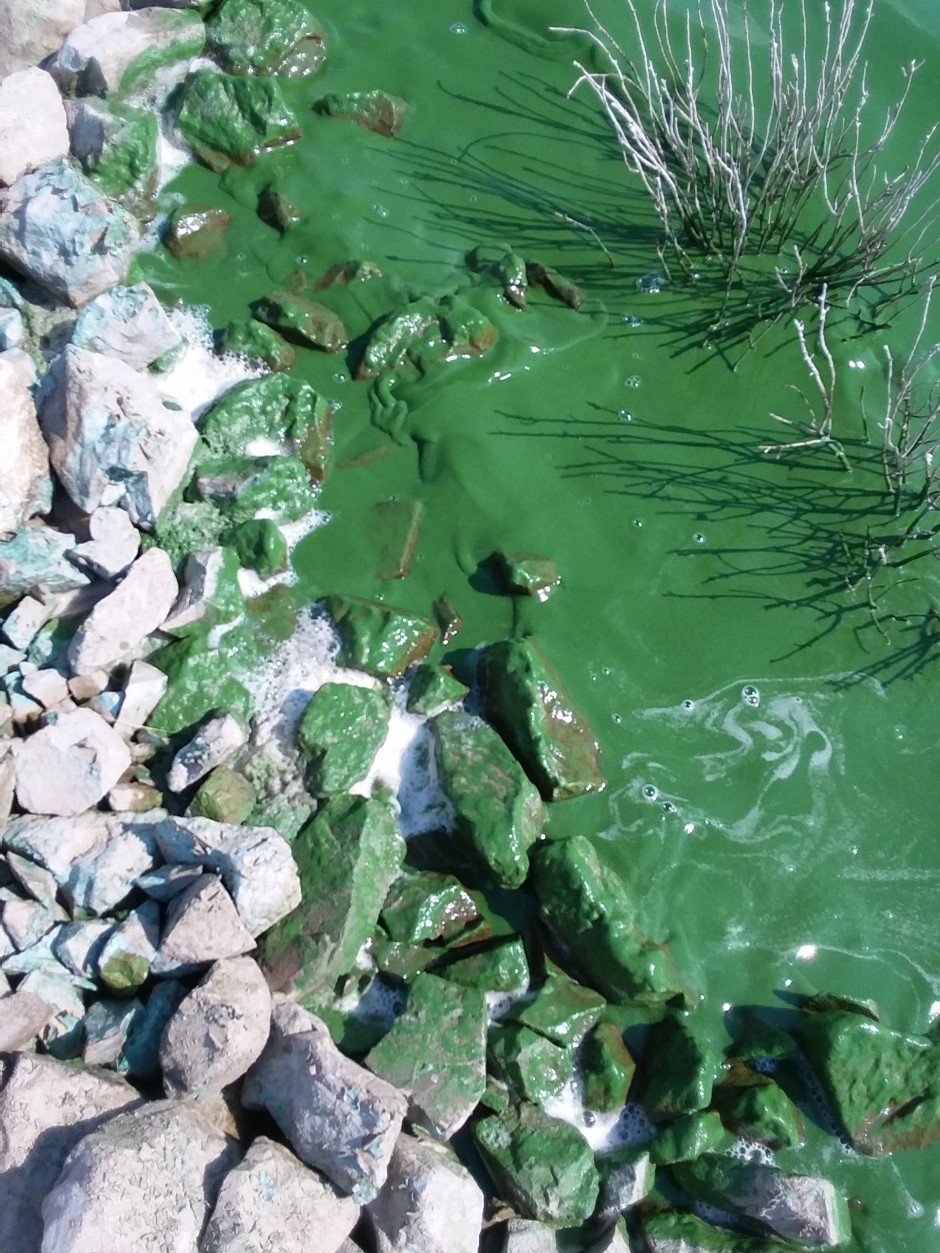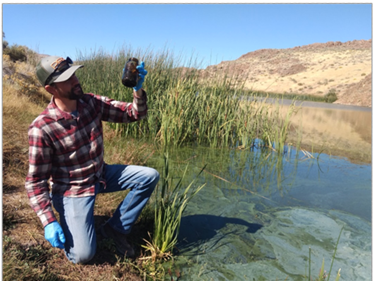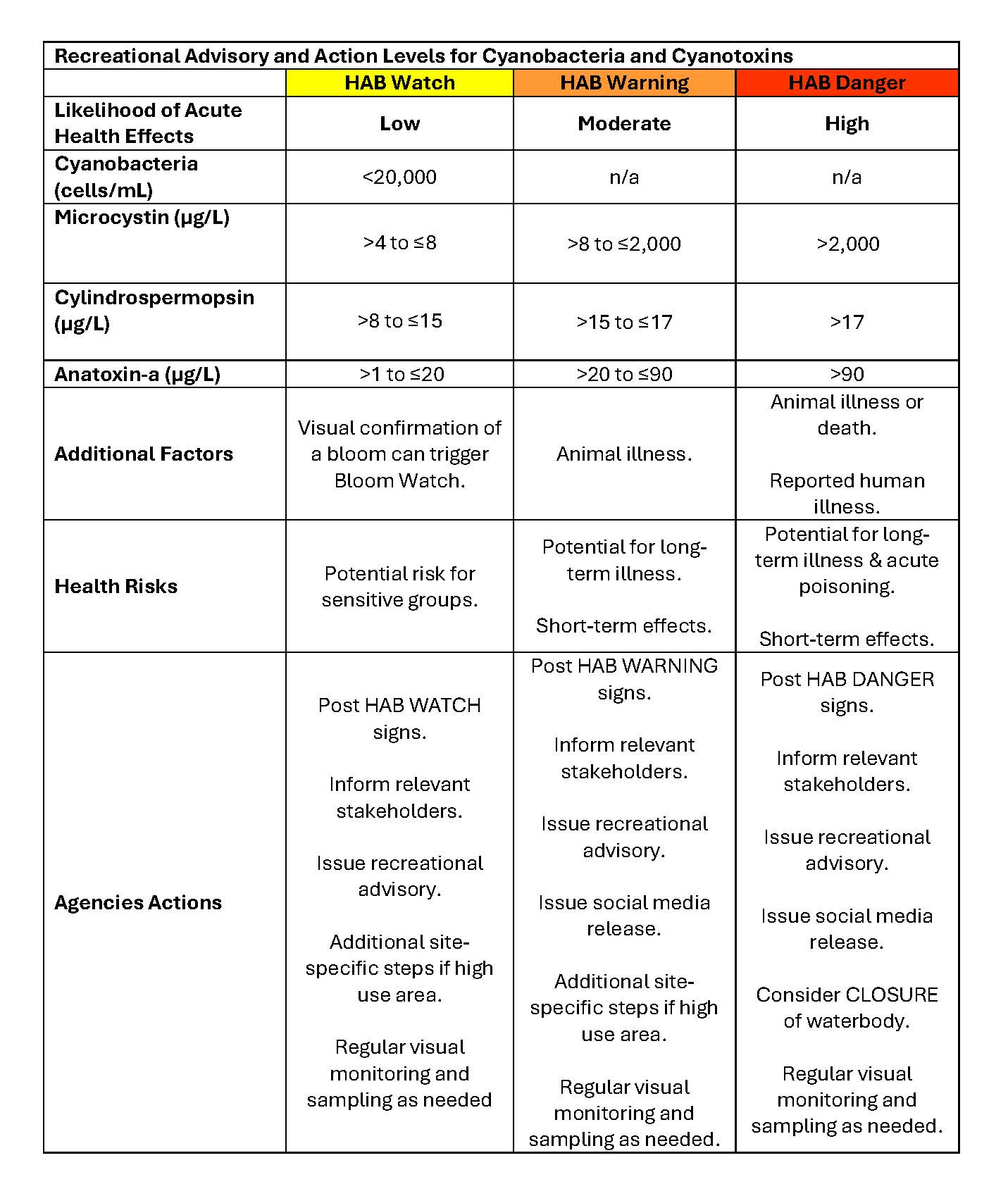Harmful Algal Bloom Program
Page Contents
Recreational Health Advisory Levels
Program Background
Harmful Algal Blooms (HABs) are caused by microscopic organisms called cyanobacteria, often referred to as blue-green algae. Some cyanobacteria can produce toxins that are harmful to humans and animals. Many cyanobacteria are adapted to high-temperature conditions, making HABs more common during the summer when water and air temperatures are warm. Environmental factors that contribute to the formation of cyanobacterial blooms in freshwater systems include:
- light availability
- water temperature
- alteration of water flow
- vertical mixing
- pH changes
- nutrient loading (nitrogen and phosphorus)
- trace metals
When environmental conditions are favorable, rapid growth of cyanobacteria can result in HABs and may impact public health and aquatic ecosystems.
Exposure to HABs can make humans sick and kill pets, livestock, and wildlife.
Humans and animals can be exposed by touching, swallowing, or inhaling water in which a HAB is present.
A HAB may be present if:
- the water smells rotten,
- large mats or scums are floating on the surface,
- the water looks like green paint,
- there are bright colors like blue, green, white, brown, or red.
However, in some cases, HABs may not be visible to the naked eye and toxins are only identifiable through laboratory analysis. Even if cyanobacteria are not visible, the water may still contain hazardous toxins. You can check for Nevada issued swimming advisories on the Nevada HAB Dashboard located on the Office of State Epidemiology website (Link to come). You may also view up-to-date HAB data before visiting water bodies. For more information on identifying HABs please visit the HABs Resources webpage.

Scope and Authority
NDEP's HAB Monitoring Program conducts routine and targeted surveillance to detect the presence of HABs. When potential HABs are identified we evaluate the potential risk to people and pets by conducting further analysis. NDEP's primary goal with this program is to provide the public with information so that people recreating in Nevada's waters can keep themselves, their families, and pets safe from the health risks associated with exposure to HABs. Another goal of the program is to identify and address the impacts of HABs in Nevada's aquatic ecosystems. The program includes participation from multiple agenices including, but not limited to:
- Nevada Divison of Environmental Protection (NDEP)
- Nevada Division of State Parks (NDSP)
- Nevada Divison of Wildlife (NDOW)
- Nevada Department of Agriculture (NDA)
- Nevada Office of State Epidemiology (OSE)
- Nevada Department of Health and Human Services (DHHS)
Program Overview
During peak HAB season (spring through summer), NDEP and partner agencies conduct regular monitoring and sampling of public surface water bodies throughout the state of Nevada. The HAB monitoring program uses a phased sampling approach that begins with regular visual monitoring and remote sensing. If a suspected HAB is observed, field staff will report their findings through the HAB reporting tool (link coming). BWQP staff will run desktop analyses on the reported site and use best professional judgment to determine the presence of a HAB. If deemed necessary, samples of affected water will be collected and analyzed. Following a visual and/or laboratory analytical confirmation of a HAB, the Office of State Epidemiology may issue a recreational advisory for the impacted water body. Advisory levels are dependent on visual confirmations and/or cyanotoxin concentrations. For more information on the HABs monitoring program please refer to the HABs Resources webpage.

Recreational Health Advisory Levels


For more information on cyanotoxin sampling and concentrations that determine Recreational Health Advisory levels please visit the HABs Resources webpage. For the most recent HAB data throughout the state of Nevada please refer to the HAB Data webpage.
HABs Exposure Information
Exposure to HABs can cause a variety of health effects, from relatively mild to potentially serious. Symptoms depend on factors such as the amount of toxins or cyanobacteria, the type of toxin or cyanobacteria, and the route and length of exposure. Studies indicate that exposure via mouth is the largest source of recreational exposure to cyanotoxins. Skin contact is also likely to be an important route of exposure to cyanobacteria. For more information regarding HABs exposures and associated health effects, please review the Guidance for HABs in Nevada Brochure (PDF).
Report a Bloom
(link incoming)
HABs Listserv
For weekly updates on HAB data and health advisories, please join the Nevada HABs e-mail list by navigating to the bottom of this webpage and clicking "Get Notices" and selecting "Nevada Harmful Algal Bloom Updates" from the dropdown menu, or by sending an e-mail directly to NEVADAHABS-subscribe-request@LISTSERV.STATE.NV.US
Frequently Asked Questions
References
Neighboring States' HABs Monitoring Programs:
- Arizona: https://azdeq.gov/AZHAB
- California: https://mywaterquality.ca.gov/habs/
- Idaho: https://www.deq.idaho.gov/water-quality/surface-water/cyanobacteria-harmful-algal-blooms/
- Oregon: https://www.oregon.gov/oha/PH/HEALTHYENVIRONMENTS/RECREATION/HARMFULALGAEBLOOMS/Pages/index.aspx
- Utah: https://deq.utah.gov/water-quality/recreational-water-quality-home#what-are-habs
https://www.cdc.gov/habs/index.html
https://www.cdc.gov/habs/illness-symptoms-freshwater.html
https://www.epa.gov/nutrientpollution/help-prevent-nutrient-pollution
https://www.noaa.gov/what-is-harmful-algal-bloom
https://nvose.org/programs/environmental-health/harmful-algal-blooms-eh/
